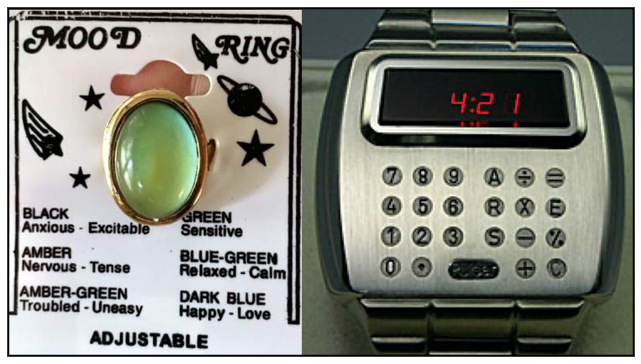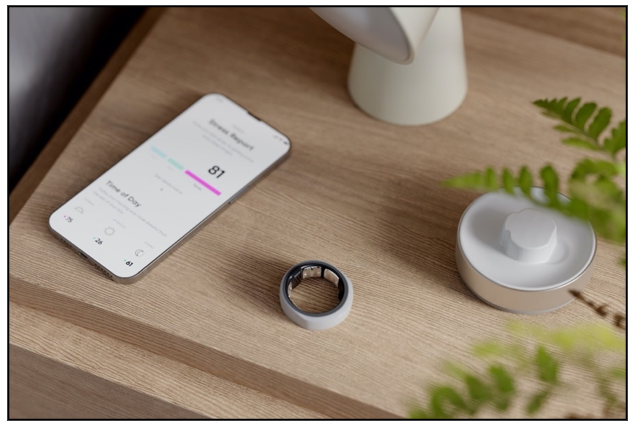In the Mood to Make Money from Wearable Technologies
 |
| By Karen Riccio |
I’ll admit it. When mood ring mania struck in 1975, I bought one of the 40 million that sold in just three months.
What was I supposed to do … not wear one and toss away whatever element of cool and trendy I managed to exude back then?
As someone who was around during the Me Decade, I wanted to get in touch with my feelings just as much as the next person and make sure everyone around me knew, too.
My ring’s stone turned violet, blue, green, yellow, gray and sometimes black — sometimes over the course of a few hours. I went from happy and active to uneasy and calm to downright anxious and harassed and, finally, confused.
Ultimately, I figured out that after taking a hot shower, washing dishes, making a snowball or grabbing a couple of ice cubes out of the freezer made my ring change colors, too.
Turns out my personal mood detector changed colors based on the temperature of my finger or if it encountered water.
The scientific explanation had something to do with sensitive thermotropic liquid crystal molecules on the stone, the absorption of wavelengths of light and shifts on the color spectrum … blah, blah, blah.
On the other hand, that first calculator wristwatch created by Pulsar in the ‘70s epitomized the combination of function, fashion and technology. Celebrities like Sting wore it, and Marty McFly sported one in “Back to the Future.”

Click here to view full-sized image.
While I no longer wear a mood ring, and I’m pretty sure Sting isn’t walking around with a calculator strapped to his wrist, versions of both these days are very much in vogue — and a whole lot smarter.
That $20 million one-year wonder for mood rings, although admirable, pales in comparison to today’s $61.3 billion global market for wearable technology and the 14.6% expected growth through 2030.
What Exactly Is
Wearable Tech?
By wearable technology, I’m talking about devices that use sensors to monitor health by keeping track of cholesterol, calories, oxygen levels, blood sugar, heart rate, steps, you name it.
They appeal mostly to health-conscious consumers, but they’ve also made a huge splash in sports and for amateur and professional athletes.
And, like I said, rings and watches remain relevant.
Startup Happy Health is just one company in the evolved mood ringesque business. Instead of color-changing stones, its Happy Ring aims to alert users about their mental health using biometric sensors and AI.

Click here to view full-sized image.
I’m talking about a ring with a “custom electrodermal activity sensor that monitors changing stress levels in real time.” It essentially detects when your nervous system kicks up a notch by measuring palm sweat, for example.
Data the ring gathers is fed into an algorithm that identifies your emotional state. The pièce de résistance is the software that accompanies it, which provides personalized exercises that are scientifically proven to help manage your stress and improve your mood and overall well-being.
Happy Health recently raised $60 million in funding as the company looks to compete with the likes of Actiwatch, Fitbit Charge 4, Whoop 3.0 and the second-gen Oura Ring.
Smart watches have evolved as well. Some of the largest developers of those include Apple (AAPL), Fitbit, Samsung Electronics (SSNLF), Garmin (GRMN) and LG Electronics.
Although you could find many of the most innovative smart watches spotlighted early in March at the Mobile World Congress in Barcelona, one — or OnePlus — is really gaining attention.
OnePlus gives smartwatches a whole new meaning. Made by Huawei, its Watch Buds combines health-monitoring tracking sensors with the tiniest of earbuds. They’re 21 mm long, 10 mm across and weigh just 4 grams.
The earbuds offer AI-powered noise cancellation, dual microphones, wear detection, wind noise suppression and a clever little gesture control system where it responds to taps on the earbud, or your actual ear.
So, as you can see, players in the wearables technology industry are not resting on their laurels. Companies continue to innovate products, catering to the masses with mental and physical healthcare solutions.
The smart ring and smartwatches barely touch on the sheer number and technologies taking consumers by storm.
And it’s only a matter of time before antiradiation underwear, smart contact lenses, smart bras, smart dentures, personal pollution alerts and “a wristwatch that keeps an eye on grandma” add to the coffers of companies looking outside the box.
How to Invest in
the Growing Trend
If you’d like to invest in wearable technology, you can always buy shares of the top five companies in that arena: Apple, Amazon.com (AMZN), Microsoft (MSFT), Alphabet (GOOGL) and Garmin. Other than Amazon, Weiss rates them all higher than a “C.”
However, if you want to capture bigger gains — and purer plays — without the risk that today’s market exposes you to, Startup Investing Specialist Chris Graebe unveiled one such opportunity in a wearable tech company just a day ago to members of his early stage investing service, Deal Hunters Alliance.
That startup is well positioned to disrupt a $100 billion industry. Click here to learn how you can claim an early stake.
Here’s to being in a good mood!
Karen

